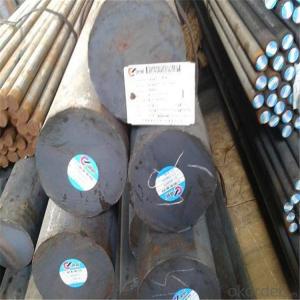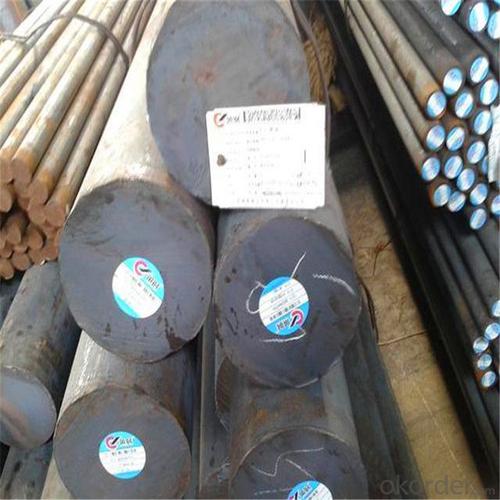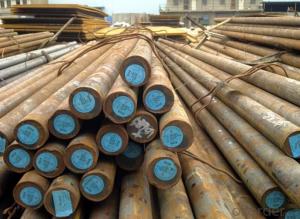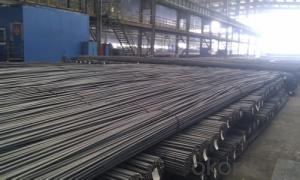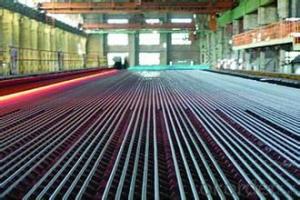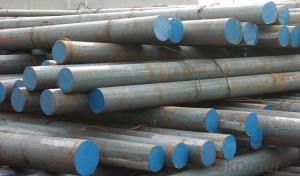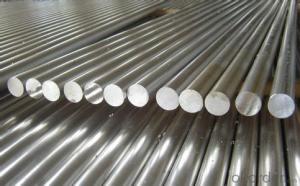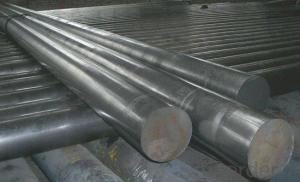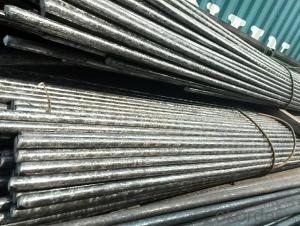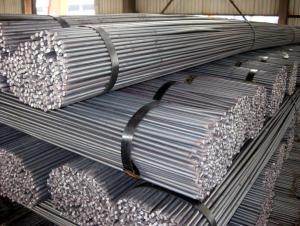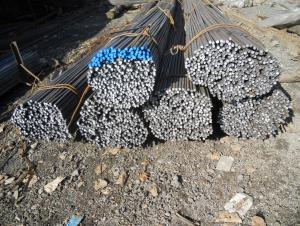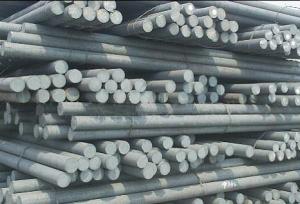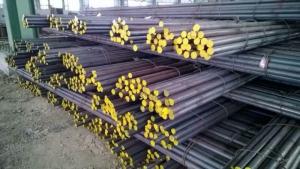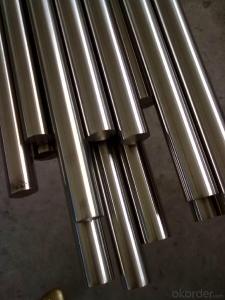ASTM A36 Round Steel Bar Large Quantity in Stock
- Loading Port:
- Tianjin
- Payment Terms:
- TT OR LC
- Min Order Qty:
- 100 m.t.
- Supply Capability:
- 500000 m.t./month
OKorder Service Pledge
OKorder Financial Service
You Might Also Like
Specification
High Quality A36 Round Steel Bar Large Quantity in Stock
Product Description of High Quality A36 Round Steel Bar Large Quantity in Stock
1. Steel grade: ASTM4140, SCM440, 42CrMo, DIN1.7225
2. Length: 6M-12M
3. Diameter: 16mm-300mm
4. Product range: round bar, flat bar, square bar
5. Technique: Hot rolled, forged, cold drawn
Specification of High Quality A36 Round Steel Bar Large Quantity in Stock
Material | SCM4140 | Round bar | Dia(mm) | 16-300mm |
Process | EAF + LF + VD + Forged + Heat Treatment (optional) | Length (mm) | Max 12m | |
Heat treatment | Normalized / Annealed / Quenched / tempered | Flat bar | Thickness(mm) | 8-500mm |
Delivery condition | Hot forged +Rough machined (black surface after Q/T)+ Turned (optional) | Width(mm) | 70-200mm | |
Test | Ultrasonic test according to SEP 1921-84 D/d | Length (mm) | Max 12m |
Chemical Composition of High Quality A36 Round Steel Bar Large Quantity in Stock
C | Si | Mn | Cr | Mo | P | S |
0.38~0.43 | 0.15~0.35 | 0.75~1.00 | 0.8~1.1 | 0.15~0.25 | ≤0.035 | <0.04< td=""> |
Photo Show of High Quality A36 Round Steel Bar Large Quantity in Stock
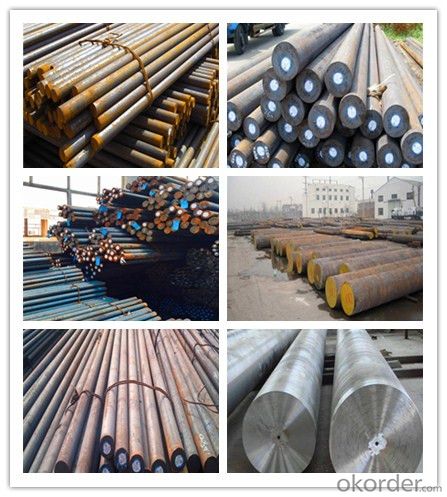
Packing and Delivery:
Packing in bundle package, or as customer's requirements.
Delivery Detail: 45 days after receiving the deposit.
Usage and Applications of High Quality A36 Round Steel Bar Large Quantity in Stock
1. Steel round bar is used in a large number of architectural and engineering structures. Or it can be used in construction of plants for the production of steel house frames, high-voltage transmission towers, bridges, vehicles, boilers, containers, ships, etc.
2. And we can use this kind of product on the performance of the mechanical parts if the demand is not very high.
3. Some special material steel round bar can be used for main shaft of steamer, hummer shank, with big section and supper force.
Company Information
CNBM International Corporation is the most important trading platform of CNBM group.
Whith its advantages, CNBM International are mainly concentrate on Cement, Glass, Iron and Steel, Ceramics industries and devotes herself for supplying high qulity series of refractories as well as technical consultancies and logistics solutions.


F A Q
1, Your advantages?
professional products inquiry, products knowledge train (for agents), smooth goods delivery, excellent customer solution proposale
2, Test & Certificate?
SGS test is available, customer inspection before shipping is welcome, third party inspection is no problem
3, Factory or Trading Company?
CNBM is a trading company but we have so many protocol factories and CNBM works as a trading department of these factories. Also CNBM is the holding company of many factories.
4, Payment Terms?
30% TT as deposit and 70% before delivery.
Irrevocable L/C at sight.
5, Trading Terms?
EXW, FOB, CIF, FFR, CNF
6, After-sale Service?
CNBM provides the services and support you need for every step of our cooperation. We're the business partner you can trust.
For any problem, please kindly contact us at any your convenient time.
We'll reply you in our first priority within 24 hours.
- Q: What is the difference between hot working and cold working of steel round bars?
- Steel round bars can be shaped and manipulated using two different methods: hot working and cold working. Hot working involves shaping steel at high temperatures, typically above the steel's recrystallization temperature. This makes the material more malleable and easier to shape. The processes involved in hot working include forging, rolling, and extrusion. Hot working has several advantages. It allows for the creation of complex shapes and sizes with minimal force or energy. It also improves the mechanical properties of the steel, such as strength and toughness, by refining its grain structure. However, hot working can cause oxidation and scale formation on the steel's surface, which may require additional treatments or cleaning. On the other hand, cold working refers to shaping steel at room temperature or below its recrystallization temperature. Cold working processes include bending, drawing, and cold rolling. Unlike hot working, cold working does not require heating the steel, which reduces energy consumption and production costs. It also results in a smoother surface finish and tighter tolerances compared to hot working. Cold working can increase the hardness and strength of the steel, making it suitable for applications that require higher mechanical properties. However, it can also make the steel more brittle and prone to cracking. In conclusion, the main difference between hot working and cold working steel round bars lies in the temperature at which the shaping process takes place. Hot working is done at high temperatures, making shaping easier and improving mechanical properties. Cold working, on the other hand, is done at room temperature or below, resulting in tighter tolerances and increased hardness. The choice between hot working and cold working depends on the desired properties and characteristics of the final product.
- Q: Are steel round bars suitable for the production of fasteners?
- Fasteners can be produced using steel round bars, which are a suitable choice. Steel is known for its strength and durability, enabling it to withstand high levels of tension and pressure. This makes it an ideal option for fasteners. Round bars, specifically, offer a smooth and even surface that can be easily machined and shaped into various types of fasteners like bolts, screws, and studs. The versatility of steel round bars allows for customization in terms of size, length, and surface finish. As a result, they are suitable for a wide range of fastening applications in industries such as construction, automotive, and manufacturing. Moreover, steel round bars exhibit excellent corrosion resistance properties when coated with protective finishes. This ensures that the fasteners have a long lifespan and can be relied upon.
- Q: How do steel round bars compare to plastic round bars?
- Steel round bars and plastic round bars have several key differences that affect their performance and suitability for different applications. Strength and durability: Steel round bars are known for their exceptional strength and durability, making them ideal for applications requiring high load-bearing capacity. They can withstand heavy loads and resist deformation or breakage. On the other hand, plastic round bars are generally less strong and durable, making them more suitable for lighter applications where strength is not a primary concern. Weight: Steel round bars are significantly heavier than plastic round bars due to the difference in material density. This can be an advantage in some applications where additional weight is desired for stability or balance. Plastic round bars, on the other hand, are lighter and can be advantageous in applications where weight reduction is important, such as in aerospace or automotive industries. Corrosion resistance: Steel round bars are known for their excellent corrosion resistance, particularly when they are made from stainless steel. This makes them suitable for applications in harsh environments or exposed to moisture. Plastic round bars, however, are generally more susceptible to degradation due to exposure to UV radiation, chemicals, or extreme temperatures. Therefore, they may not be as suitable for outdoor or corrosive environments. Versatility: Steel round bars offer a wide range of options in terms of size, shape, and grade. They can be machined, welded, bent, or shaped to suit various applications. Plastic round bars also come in different shapes and sizes, but their versatility is somewhat limited compared to steel. They may not be as easily machined or welded, and their performance can be affected by temperature fluctuations. Cost: Steel round bars are generally more expensive than plastic round bars due to the higher cost of raw materials and manufacturing processes. Plastic round bars, on the other hand, are more affordable and can offer cost savings in certain applications. In summary, steel round bars offer superior strength, durability, and corrosion resistance, making them suitable for heavy-duty applications. Plastic round bars are lighter, more affordable, and can be advantageous in applications where weight reduction is important. Ultimately, the choice between steel and plastic round bars depends on the specific requirements of the application and the trade-offs between strength, weight, cost, and corrosion resistance.
- Q: What are the different surface conditions for steel round bars?
- Steel round bars can have a variety of surface conditions depending on how they will be used and how they are made. Some commonly used surface conditions for steel round bars are: 1. Hot Rolled: This is the most common surface condition for steel round bars. It involves heating the steel above its recrystallization temperature and then rolling it through hot rolling mills. This process gives the steel a rough surface with a layer of scale that needs to be removed. 2. Cold Drawn: In this surface condition, the steel round bars are pulled through a die at room temperature. This creates a smoother and more precise surface finish. Cold drawn bars have better dimensional accuracy and surface quality compared to hot rolled bars. 3. Peeled: Steel round bars can also be peeled to remove the scale layer and achieve a smooth surface finish. This process involves rotating the bar against a cutting tool, resulting in a clean and shiny surface. 4. Ground: Grinding is another method used to achieve a smooth surface finish on steel round bars. It involves removing material from the surface using abrasive belts or wheels, resulting in a precise and consistent surface. 5. Polished: Polishing is a surface treatment that enhances the appearance and smoothness of steel round bars. It involves using abrasive compounds and buffing wheels to create a reflective and mirror-like finish. 6. Coated: Steel round bars can be coated with different materials to improve their resistance to corrosion or enhance their appearance. Common coatings include zinc, chrome, nickel, and various types of paint. The choice of surface condition for steel round bars depends on the specific application and desired properties. Each surface condition offers different advantages in terms of appearance, corrosion resistance, and mechanical properties.
- Q: What is the minimum yield strength of steel round bars?
- The specific grade and type of steel being used can cause the minimum yield strength of steel round bars to vary. However, the majority of steel round bars generally possess a minimum yield strength of 36,000 psi (pounds per square inch) or 250 megapascals (MPa). This minimum yield strength ensures that the steel round bars are strong enough to resist applied loads and avoid deformation or failure. It is worth mentioning that certain applications may demand steel round bars with higher yield strengths to fulfill particular performance criteria.
- Q: Can steel round bars be annealed?
- Yes, steel round bars can be annealed. Annealing is a heat treatment process that involves heating the steel to a specific temperature and then gradually cooling it down. This process helps to relieve internal stresses, improve ductility, and enhance the material's machinability. Annealing can be applied to a wide range of steel products, including round bars, to make them softer, more workable, and reduce the risk of cracking or failure during subsequent manufacturing processes.
- Q: What are the advantages of using case-hardening steel round bars?
- Case-hardening steel round bars offer several benefits for various applications. To begin with, these round bars possess a toughened outer layer, known as the "case," while maintaining a softer and more malleable core. This unique combination allows for exceptional surface wear resistance, making them highly suitable for situations where the material encounters abrasive or erosive forces. Furthermore, the hardened outer layer enhances the overall strength and durability of the round bars, thereby extending their lifespan. Another advantage of case-hardening steel round bars lies in their remarkable ability to withstand heavy impact loads. The hardened outer layer acts as a protective barrier, effectively absorbing and dispersing the energy from impacts, thus preventing any deformation or breakage. This makes them particularly well-suited for applications involving substantial loads or impacts, such as in the fields of machinery or construction equipment. Moreover, case-hardening steel round bars provide enhanced resistance against fatigue. The hardened surface layer aids in distributing stresses evenly, reducing the likelihood of cracks or fractures developing during cyclic loading conditions. Consequently, they prove to be an excellent choice for applications that demand long-term durability and the ability to withstand repeated stress, such as in automotive components or gears. Additionally, these round bars demonstrate excellent machinability. The soft and malleable core allows for easy cutting, drilling, and shaping, while the hardened surface ensures the necessary wear resistance. This aspect makes them both cost-effective and efficient to work with, enabling them to be effortlessly molded into various shapes and sizes to meet specific design requirements. In conclusion, the utilization of case-hardening steel round bars offers a plethora of advantages, including outstanding wear resistance, high impact load resistance, improved fatigue resistance, and excellent machinability. These characteristics render them a versatile and dependable choice for a wide array of applications across industries such as automotive, construction, and manufacturing.
- Q: How can steel round bars be protected against corrosion?
- Steel round bars can be protected against corrosion through various methods. One common method is the application of a protective coating such as paint or epoxy. The coating acts as a barrier between the steel surface and the corrosive elements in the environment, preventing direct contact and thus reducing the risk of corrosion. Another effective way to protect steel round bars from corrosion is by galvanizing them. Galvanization involves coating the steel with a layer of zinc, which acts as a sacrificial anode. The zinc layer corrodes instead of the steel, providing a long-term protection against corrosion. Regular maintenance and inspection are also important in preventing corrosion. This includes removing any rust or scale that may have formed on the surface of the steel round bars, as these can accelerate the corrosion process. Additionally, keeping the steel round bars dry and free from moisture is essential, as excessive exposure to water or humidity can lead to corrosion. In industrial environments or areas where corrosive chemicals are present, it may be necessary to use specialized corrosion-resistant alloys for the steel round bars. These alloys, such as stainless steel or nickel alloys, have a higher resistance to corrosion and can withstand harsh conditions better than regular steel. Overall, the key to protecting steel round bars against corrosion is a combination of proper coatings, regular maintenance, and selecting the appropriate materials for the specific environment in which they will be used.
- Q: Are steel round bars suitable for marine propeller applications?
- Indeed, marine propeller applications find steel round bars to be a fitting choice. The utilization of steel as a prevalent material for marine propellers arises from its exceptional attributes of robustness, endurance, and resistance to corrosion. By machining and shaping steel round bars into the desired configuration for propeller blades, one can achieve remarkable performance within a marine setting. Furthermore, steel exhibits the ability to endure the substantial stresses and forces encountered by propellers in water, rendering it a dependable option for marine propulsion systems.
- Q: Can steel round bars be bent or formed into shapes?
- Steel round bars possess the ability to undergo bending or shaping into different forms. Due to its exceptional strength and durability, steel is widely recognized as a versatile material suitable for various purposes. To achieve the desired shapes, steel round bars can be bent or formed using diverse techniques such as heating, hammering, or utilizing specialized machinery like hydraulic presses or roll benders. These methods enable the steel bars to be molded into curves, angles, or specific configurations in order to meet the desired requirements. However, it is important to acknowledge that the flexibility of a steel round bar to undergo bending or shaping is contingent upon factors including its diameter, type of steel, and the specific technique employed for bending or forming.
Send your message to us
ASTM A36 Round Steel Bar Large Quantity in Stock
- Loading Port:
- Tianjin
- Payment Terms:
- TT OR LC
- Min Order Qty:
- 100 m.t.
- Supply Capability:
- 500000 m.t./month
OKorder Service Pledge
OKorder Financial Service
Similar products
Hot products
Hot Searches
Related keywords
